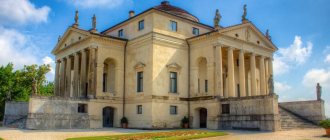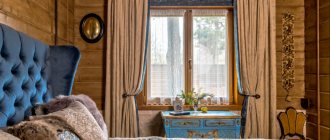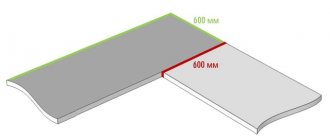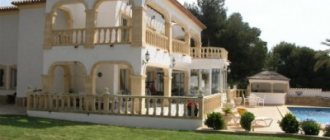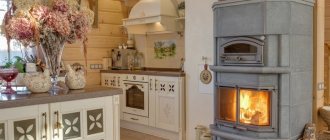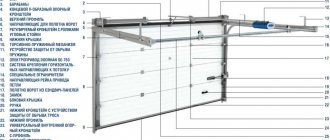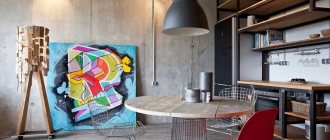Gothic fashion is back. Such houses conquer the hearts of romantics; the Gothic mysticism amazes the imagination. Today, country houses in the Gothic style are no longer gloomy medieval castles, but unique buildings erected in an exclusive format. But fundamentality and reliability are the features that have survived to this day. Undoubtedly, a country house in the Gothic style will fit perfectly into the environment, will look harmonious and will favorably represent your tastes. And here a professional approach is important - you need a strong, solid building that clearly corresponds to the given concept, and the garden landscape, in turn, must highlight everything favorably.
How Gothic appeared
The date of birth of the Gothic style in architecture is precisely known. Abbot Sugeria started rebuilding the dilapidated church at the French Abbey of Saint-Denis. Upon completion of the reconstruction, in 1144, a temple appeared before the world, built in a hitherto unknown style, later called Gothic.
The abbot revealed the symbolism of the unusual appearance of the church. According to his idea, the temple is a ship that carries the flock to the mountain heights. The analogy lay on the surface - the vaults resembled sails that caught the wind, and the high columns resembled ship masts. The nave (the space highlighted by columns) is translated from Latin as “ship”.
The first Gothic church was in keeping with the spirit of the times, it was at the same time significant, sublime and impressive. Success caused the spread and further development of Gothic architecture, first in France, and then in Germany, Italy, Britain and other countries.
Interior of Exeter Cathedral Source farm2.static.flickr.com
In its approach to construction, Gothic architecture was fundamentally different from the previous, Romanesque style. Architects discovered a new way of influencing the load on a building, in which the weight and pressure of the masonry were not distributed along the entire perimeter, as before, but were concentrated at certain points. At the same time, the load on other parts of the structure was minimal.
The discovery made it possible to replace the usual cylindrical vault with a new, rib vault, which received its name from the characteristic protruding ribs - ribs that carry the load in the Gothic frame cross vault. The revolutionary frame system opened up impressive possibilities for the construction of the highest and at the same time mystical-airy temples, some of which exceeded the height of the Cheops pyramid.
Structure of the frame system Source cf.ppt-online.org
See also: Catalog of companies that specialize in the installation of fireplaces and stoves
Installation of false columns
Polyurethane foam decorative elements have a smooth back surface. It should be adjacent to the façade wall. Any column consists of two main parts:
- trunk;
- capitals.
The capital is the figured part crowning the trunk. The installation of the column is carried out in stages: first, the main part (trunk) is attached, then the capital.
Step 1. Marks are applied to the façade to determine the location of the decorative elements.
Step 2. Perform “fitting”: apply the part to the facade. If the height of the house is such that the length of one false column is not enough, cut off the missing part from the other column. To complete the task, use a hacksaw with a fine tooth or a jigsaw with a similar file.
Step 3. Mark the locations for drilling holes in the wall that are necessary for installing the column. Fasteners must be at a distance of at least 1 cm from the ends of the part. Holes in the wall are drilled in increments of 40-50 cm. Use a drill (perforator) and a drill bit with pobedite tip. The optimal depth of the holes is 7-8 cm.
Step 4. Use metal pins or dowel nails as fasteners. In the first case, you will need to drill holes on the back side of the column. The depth is determined depending on the thickness of this decorative element.
If you decide to fasten the trunk using dowel nails, a plastic part is driven into the holes in the wall: dowels.
Step 5. Place the column against the wall or either place it on metal studs pre-installed in the holes, or secure it by screwing self-tapping screws into dowels.
Step 6. To connect the two parts of the barrel together, you will need metal corners. The lower part of which is attached to the horizontal section of the lower part of the trunk, the side – to the wall of the building.
Step 7 . The upper part of the column is fastened: the capital. Use the same technique as when installing the barrel.
Step 8 . Use moisture-resistant putty to mask the screw heads.
Measure the height of the walls and, if necessary, adjust the column body
When installing a column, three parts are used: base (bottom), body (base, trunk), capital (top). Before installing the column, check all elements and their dimensions
First attach the capital to the body using polyurethane joint adhesive. Let the glue dry
Also connect the base and body using joint glue. Column assembled
Even when assembled, the column is light in weight, making it easy to install
Having installed the column in a pre-selected place, wait until the glue in the places where the elements join is completely dry. After this, you can paint the decorative element
Video - Installation of polyurethane columns
Style development
The canons of the Gothic style in architecture differ somewhat from country to country. In general, European Gothic is usually divided into three types, according to the following intervals:
- Early (lancet). Between 1140 and 1250, the transition to the Gothic style, exemplified not so long ago by Notre Dame Cathedral, was completed. A characteristic feature of the buildings is the combination of powerful walls, a majestic portal above the entrance and high arches. This is how mainly churches and cathedrals are built, and a little later castles.
Notre Dame de Paris, Notre Dame Cathedral Source www.ediscover.ru
- Tall (mature). The period lasted for two centuries. From 1194 to 1400, early Gothic improved, the frame structure became more complex, and the number of stained glass windows and sculptural groups increased. The Gothic style is gaining recognition as a trend in European urban architecture; its merits can be judged, for example, by the cathedral in Reims.
- Late (flaming). Covers the period from approximately 1350 to 1550. Much attention is paid to decorative details, the style becomes more refined and ornate (hence the name). A new development was achieved in the form of sculptural compositions on religious and secular themes. Late Gothic buildings include the Milan Cathedral.
Milan Cathedral Source wikimedia.org
Seville Cathedral. Seville, Spain
The Cathedral of Seville (The Cathedral in Seville) - Cathedral of Santa María de la Sede - a temple building in Andalusia, in the city of Seville. This is the tallest cathedral in Spain. The length of this Gothic building was 126 meters, width - 82 meters.
Seville Cathedral. (1402-1506) Erected on the site of a destroyed mosque during the Reconquista.
On the site of the cathedral during the occupation of Spain by the Moors, there stood the Muslim Almohad Mosque, which was destroyed during a strong earthquake in 1356. After the expulsion of the Moors, on its foundation and using the materials remaining from the destroyed buildings, the construction of a Christian temple began, which was supposed to become a symbol of wealth and forces of Seville. Construction began in 1402 and was completed in a relatively short time - by 1506. However, even despite the short period of construction of the Gothic building, elements of the Renaissance are already noticeable in its architecture. Next to the cathedral is the Giralda bell tower (from the Spanish “girar”, which means “to spin”), richly decorated with ornaments and patterns. This building was rebuilt from a former minaret in 1560-1568. architect Hernan Ruiz, who built the minaret with additional tiers, tapering upward. On the lower tier there are 25 bells, on the last tier there is a bronze figure-weathervane with a banner (1568 sculptor Bartolome Morel).
Main features of Gothic architecture
The medieval cathedral was the center of city life, and was built to accommodate the entire city population. Preachers spoke on the square in front of the cathedral, traveling artists staged performances, and professors and students held discussions. The Gothic style in architecture owes its external charm and performance qualities to the following characteristic features:
- The Gothic style is the characteristic, skyward appearance of all parts of the structure, including spiers, elongated stained glass windows, and narrow turrets.
- Frame construction system. Thanks to its appearance, buildings began to grow higher, and the thickness of the load-bearing walls became smaller.
Buttresses and flying buttresses Source i.pinimg.com
- Pointed arches. They coped well with the load of the upper arch, redistributing it to the lower structures. Thanks to the arrow-shaped arches, it became possible to do without many internal walls, which was impossible in the Romanesque style.
- Additional designs. Arches in the form of arcs and crosses, as well as hanging external semi-arches that can transfer the load outside the building.
- Various decor of the Gothic facade: archivolt (frames of arched spans), wimperg (pointed gable above a window opening or portal), “big rose” (central window of the cathedral), facade decorated with carvings.
Stained glass in a modern interior Source lunev-design.ru
Manufacturing technology of soldered stained glass
Step 1 . On a template fixed on the desktop, mark what color each element of the picture will be. You can apply marks with colored felt-tip pens or sign with a simple pencil.
Step 2. Select a piece of glass of the desired color and place it on top of the corresponding part of the picture.
Transferring details to film
Cut out the film and lay it on the glass
Step 3. If the lines of the design are clearly visible through the glass, draw along the contour of the part with a glass cutter. If the lines are hard to see, draw them on the glass. When working with a glass cutter, you must adhere to the recommendations of stained glass art masters:
- the glass surface must be clean (if necessary, it must be degreased);
- the cut should be fast enough and uniform, without excessive pressure;
- when the cut is performed correctly, the characteristic sound of glass cracking should be heard;
- 5-7 mm before the final cutting point, you need to release the pressure on the glass;
- You cannot use a glass cutter several times along the same line.
Cutting out the details
Breaking off the part
Breaking glass
Step 4. Turn on the grinding machine and bring the edge of the glass to the rotating head. Lightly touching the mechanism, grind the part. During work, they perform a “fitting”: they place the cut element of the design on the template and check the conformity of the dimensions and curves of the lines.
The part needs to be ground on a grinder so that the edges are smooth.
Grinding
Step 5. The ground piece of glass is wrapped with adhesive foil tape. To perform this task, you can use special tools: rollers. But you can do without them. The tape is glued so that its edges cover the glass on both sides, protruding 1 mm beyond the edge. Therefore, the width of the tape must correspond to the thickness of the glass, taking into account this requirement.
Wrap the edges with foil
Laying out the details on the sketch
All parts are packed
Step 5. When part of the drawing is ready and all its cut-out glass elements are laid out on the template, begin soldering. Heat the soldering iron to the desired temperature, take a rod of solder and apply it to the junction line of the two pieces of glass.
Step 6 . Touch the solder with a soldering iron and “drive” the solder along the line of the drawing.
We carry out soldering
Step 7 . After all the joints between the elements of the template have been worked out, the glass sheet is turned over and the same work is done again: solder the pieces of glass to each other.
Step 8. When several modules of the drawing are ready, begin to connect them using broaching. At this stage of work, an H-shaped profile is used. It is flexible enough to join glass even with complex curves.
Step 9. After assembling the stained glass window, it needs to be installed in the frame. If the fabric turns out to be quite lightweight, you can use wooden glazing beads with a slot. In this case, you will need a Y-shaped profile, the narrow part of which is inserted into the slots.
For heavy stained glass windows, wooden or metal frames with a U-shaped section are used. The width of these strips should correspond to the thickness of the glass, taking into account two layers of solder and adhesive tape.
Step 10. The stained glass window in the frame is installed in the window opening.
Main features of the interior
The combination of architectural innovations made it possible to significantly expand the internal space, which also did not go unnoticed. Thanks to the high pointed arch, reminiscent of a tree with branching branches, the interior of the Gothic building seems weightless and mysterious, despite the fact that the main building material was stone.
A characteristic feature of the Gothic interior is the skillful use of direct and diffused light. The huge space of the cathedral needed high-quality lighting. The required amount of light was provided by large lancet windows decorated with stained glass, ornaments, and turrets.
Windows made of colored glass played an important decorative role, showing parishioners colorful illustrations of biblical and secular subjects. The vaulted ceilings also contributed; their device made it possible to diffuse the light so that there were no shadows.
Knight's Hall Source i2.wp.com
Gothic is a distinctive style that has influenced all aspects of people's lives. The interiors of castles and town houses are moderately modest and, to the taste of a modern person, romantic. They are characterized by the following design techniques:
- Wooden panels were used to cover the stone walls, which were decorated with bright paintings, wood engravings and carpets. Windows in medieval houses were glazed, but no one had ever heard of curtains.
- The flooring was boards, stone, and later tiles. In the living area, the floor was covered with carpets.
Modern interpretation Source i.pinimg.com
- The traditional medieval ceiling had a beam structure with open rafters, while false ceilings were common. They were lined with boards or slats, and often decorated with paintings.
- A luxurious, richly decorated fireplace is a sign of French and English interiors. In Germany and other northern countries, from the mid-15th century they began to be replaced by tiled stoves.
Recreation area Source vseznayko.com
- The furniture, hewn with an ax from solid wood, is characterized by heavy proportions. In the 15th century, after the advent of the technology of making sawn boards, almost all modern types of furniture appeared. By the middle of the Middle Ages, furniture was richly decorated with carvings, gilding, and painting.
- The set of Gothic furniture included carved cabinets, tables and chairs, armchairs and beds with a canopy that protected from drafts walking through the spacious room.
- A familiar and extremely useful interior detail was a chest in which things were stored and on which people sat.
Late Gothic furniture
Sleeping on four-poster beds
Gothic furniture is made of wood or metal. It is distinguished by its massiveness and good quality frame and is decorated with complex carvings. In fact, large-sized furniture (beds, wardrobes, tables) does not look awkward, but rather graceful and elegant. Gothic beds have columns on which a canopy made of thick textiles is installed. Now the columns and canopy are being replaced by a tall, beautiful headboard.
Photo: bedroomfurniture.club
Photo: imagebin.me
Photo: postfreehome.com
Video description
About the Gothic style in interior design in the following video:
Examples of interior in the Gothic style: photos
Gothic bedroom Source oir.mobi
Office in a large mansion Source oir.mobi
Modern living room Source www.lalulalang.site
Bedroom in dark colors Source mykaleidoscope.ru
Gothic living room in pastel colors Source mykaleidoscope.ru
Room on the attic floor Source static.tildacdn.com
Cabinet in Gothic style Source mykaleidoscope.ru
Hall in a large mansion Source mykaleidoscope.ru
Gothic in a modern interior Source vitospb.ru
Fireplace in the interior Source hthomedecor.com
For those who love dark notes in the interior Source tapety.tja.pl
Living room in an old style Source mykaleidoscope.ru
Gothic in the kitchen Source jackwharperconstruction.com
Modern Gothic with a combination of dark and light tones Source vasha.com.ua
Kitchen with island in Gothic style Source images.homify.com
Decor
Exquisite details that smell of antiquity create an amazing mosaic of a Gothic interior. Without tastefully selected accessories, the design will not achieve the desired completeness. Not only guests, but also the owners themselves will be pleased to look at the fancy little things that have settled on the shelves and tabletops.
Cups, sculpture, antiques - suitable accessories for decoration
Select antique vases, metal trays, candelabra, crosses, and small sculptures. Knight paraphernalia like crossed swords and a shield will look great. Or maybe you can even install a whole rack of armor?
Surprise your guests with real knight's armor!
Significant Gothic objects are also tapestries, stained glass, a fireplace behind a forged grate, and a throne chair. Don’t skimp on decorating elements; they are the ones that allow you to completely immerse yourself in a fairy tale.
An iconic element of the Gothic style is the stained glass rose or rosette. It is a round window divided into parts by a figured binding. A flower or star pattern is formed in the center. This type of decor can be used to decorate not only windows, but also walls or even the ceiling.
Stained glass rose in the interior
Neo-Gothic and modernity
Interest in the Gothic style in architecture was revived at the end of the 18th century and was marked by the emergence of a new direction - neo-Gothic, characteristic, for example, of the campuses of reputable educational institutions. Secular buildings also appeared, for example, the city council building in Munich or Berlin.
The Gothic interior design of the houses of noble Europeans took shape towards the end of the 19th century, when the fashion for lush and at the same time gloomy decor in the style of a knight's castle appeared. Today it can hardly be called universal: it is of little use for decorating a standard living room, but it looks good in a spacious room in a country estate. To embody the modern Gothic style, one cannot do without a certain stylization and the following elements:
- Spacious room with high ceilings and large windows.
Gothic bedroom Source i.pinimg.com
- Use of natural materials: wood, stone, metal.
- Characteristic palette: blue-black, golden, brown, violet, emerald, dark blue, rich red and silver.
Interior with fireplace Source roomester.ru
- To prevent the interior from becoming too gloomy, the palette is diluted with light colors, or, as an option, mixed with other styles.
- Furniture with medieval charm: heavy, carved, with forged parts, decorated with gilding and painting. Upholstery made of luxurious fabrics, velvet or brocade in dark shades will look harmonious.
Light Gothic Source kstudiosdesign.files.wordpress.com
- Accessories. Details are an important part of the medieval setting. Don’t forget about stained glass windows, themed tapestries, and bronze candlesticks. The worn leather chest looks like an atmospheric detail.
- Lighting. The finishing touch will be a forged chandelier with lamps in the shape of a candle in the wind, which will be complemented by suitable lamps and sconces.
Kitchen-dining room Source roomester.ru
Installation of false facade
In order to give the building a Gothic flavor, it is necessary to decorate the facade in the appropriate style. Before starting work, it is recommended to carefully examine photos of Gothic cathedrals and castles and select decorative elements suitable for a particular building.
Gothic is characterized by gloomy gray tones. Therefore, facade panels that imitate natural stone masonry are suitable.
vinyTherm facade panels
Vinylit facade cladding panels with natural stone chips
You can install polyurethane false columns and arches, which will create the impression of massive openings and vaults characteristic of the Gothic architectural style. But it should be noted that polyurethane foam is a white or other light-colored material. All of them are unusual for Gothic. Therefore, the columns and arches will need to be painted gray or another chosen color.
Tops of columns of a gothic English cathedral
Prices for types of false facades
False facade
Decoration of the facade with false columns
When choosing polyurethane foam decorative elements, you need to take into account that most of the false columns offered by manufacturers have an openwork frame. These decorative elements are suitable for decorating a facade in the Baroque style. Gothic style is characterized by simplicity and laconic lines. Therefore, you need to choose those elements that have as few frilly curls as possible.
Molded decor made of polyurethane
The whole complex of work can be divided into three stages:
- façade preparation;
- installation of decorative elements;
- coloring of polyurethane foam.
Prices for ready-made stucco columns
Stucco columns
Preparatory stage
First of all, you need to visually inspect the walls and make sure that they do not require cosmetic repairs. If the situation is the opposite, proceed to preparing the facade.
Step 1. Remove the old finishing layer from the walls.
Step 2. If there are cracks, clean them, simultaneously removing all loose particles.
Removing old coating
Step 3. Dust the surface using a rag or vacuum cleaner.
Step 4. Prime the walls with 1-2 layers, using special compounds for treating facades.
Padding
Step 5. Seal the cracks using a cement-sand mortar prepared in a 3:1 ratio (one part of cement of a grade not lower than M400 and 1 part of quarry sand).
Repairing cracks
Step 6. In those places where it is necessary, apply a layer of plaster and level it. Then the plastered surface is grouted using a special tool: a grater. This approach will ensure smooth walls.
Prices for popular types of plaster
Plaster
Video description
About design ideas in the spirit of a medieval castle in the following video:
Photos of modern houses in the Gothic style
Small modern house Source upload.wikimedia.org
Country house Source stroimnovyidom.ru
French Gothic in modern houses Source proekt-sam.ru
Black Gothic house Source i.pinimg.com
A mixture of modern and Gothic style Source mir-s3-cdn-cf.behance.net
Small modern house in neo-Gothic style Source i.pinimg.com
Gothic house in a snowy garden Source i02.fotocdn.net
Wooden house in black Source i.pinimg.com
Modern Gothic in the Czech Republic Source cdn.jhmrad.com
House with bay windows Source silka.com.ua
Small country house Source stroimnovyidom.ru
Gothic mansion with terrace Source smarthomemaking.com
Brick country house Source cdn.jhmrad.com
Two-story building with an attic Source i.pinimg.com
Eastern Gothic Source i.pinimg.com
1) Choose your building site carefully
It is extremely important to build your castle on high ground and at a strategic point.
Castles were usually built on natural elevations, and were usually equipped with a link connecting them with the external environment, such as a ford, bridge or passage.
Historians have rarely been able to find evidence from contemporaries regarding the choice of location for the construction of the castle, but they still exist. On September 30, 1223, 15-year-old King Henry III arrived in Montgomery with his army. The king, who had successfully carried out a military campaign against the Welsh prince Llywelyn ap Iorwerth, was planning to build a new castle in this area to ensure security on the border of his possessions. The English carpenters had been given the task of preparing the wood a month earlier, but the king's advisers had only now determined the site for the construction of the castle.
Montgomery Castle, when it began to be built in 1223, was located on a hill
After a careful survey of the area, they chose a point on the very edge of a ledge overlooking the Severn valley. According to the chronicler Roger of Wendover, this position "looked unassailable to anyone." He also noted that the castle was created “for the security of the region from frequent attacks by the Welsh.”
Advice
: Identify areas where the topography rises above traffic routes: these are natural locations for castles. Keep in mind that the design of the castle is determined by where it is built. For example, a castle will have a dry moat on a ledge of outcroppings.
Design features of the medieval castle project
1. Project of a house in the medieval style “VASSAL CASTLE” with a total area of 1007 m22. The relative level of 0.000 is taken to be the level of the finished floor of the first floor, equal to the absolute level - which is determined after the medieval castle is planted according to the project on a specific site.3. The outer walls of the house in a medieval style are made using the B1ie Max technology. The thickness of the external walls is 360 mm. including drywall on the premises side. (29 + 70)4. Monolithic reinforced concrete floors on metal beams (concrete m 300 b = 100 mm), floor thickness 70 mm5. The external walls of the house in the medieval style are decorated with plaster parts, forged items and plastered for subsequent painting in agreement with the architect.6. The basement walls are made of monolithic concrete with insulation (see section KR). The base is lined with artificial stone.7. Internal partitions are plasterboard on a metal frame, 152mm thick.8. The windows are made of PVC, using double-glazed windows, the profile color is “golden oak”, with anti-mask nets on the tilt-and-turn windows.9. External doors are insulated metal with stained glass windows. (see specification for filling doorways). White insulated garage doors.
10. The distribution of utilities is carried out in the space of the false ceiling. 1st floor 3050 mm (clean 2nd floor 3050 mm base 3050 mm floor heights
11. According to the project, the main entrance staircase of the medieval castle is made of concrete and tiled.12. Warm electric floors are installed in the following rooms: stairs and landing, vestibule of the main entrance.13. The roof structures are wooden rafters. Roof covering (roofing) - bitumen tiles. "BP" color - Arsylse gizidie 14. All dimensions are given in mm, marks in m. 15. Color of soffit lining and gutters - white 16. Internal staircase is made of monolithic reinforced concrete with tile cladding. Real drawings of the house in in the form of a castle are made in accordance with current building standards and rules, including explosion and fire safety, and provide solutions that ensure safety while observing the established rules for operating a house in the form of a medieval castle.
General instructions for the electrical supply of a house in the form of a medieval castle
Working drawings for the project of a medieval house were developed on the basis of a design assignment. According to the degree of reliability of power supply, this object belongs to consumers of category III. The estimated power on the roof is 20 kW. The low-voltage line is provided from the existing support of the overhead line - 0.4 kV. The wire is adopted to be self-supporting with aluminum phase conductors conductors, with insulation made of light-stabilized cross-linked polyethylene, with a supporting conductor made of aluminum alloy type SIP-2A with a cross-section of 4x25mm2
The selected wires are checked for permissible voltage losses, the value of normalized voltage deviations at electrical receivers complies with the requirements of GOST 13109-87 (+5%)
5) Prepare the landscape
When building a castle, you may have to move a significant amount of earth, which is not cheap.
It is often forgotten that the castle’s fortifications were built not only through architectural techniques, but also through landscape design. Huge resources were devoted to moving land. The scale of the Norman land work can be considered outstanding. For example, according to some estimates, the embankment built around Pleshy Castle in Essex in 1100 required 24,000 man-days.
Some aspects of landscaping required serious skill, especially the creation of water ditches. When Edward I rebuilt the Tower of London in the 1270s, he hired a foreign specialist, Walter of Flanders, to create a huge tidal ditch. Digging the ditches under his direction cost £4,000, a staggering sum, almost a quarter of the cost of the entire project.
An 18th-century engraving of the 1597 plan of the Tower of London shows how much earth had to be moved to build the moats and ramparts.
With the increasing role of cannons in siege art, the earth began to play an even more important role as an absorber of cannon shots. Interestingly, experience in moving large volumes of earth allowed some fortification engineers to find work as garden designers.
Advice
: Reduce time and cost by excavating the stonework for your castle walls from the moats around it.
Materials used
What building materials to use is a personal matter for the developer
Expensive or cheap does not matter, because for a stylized medieval building it is important that all materials are of natural origin
The use of alternative types of building materials will not be able to make the conceived idea of building a castle a reality. With such materials, the design will only have similarities, but will in no way resemble a real castle.
Interior walls can be treated with cladding material or decorative wallpaper resembling marble or brick.
Designing a castle house may include the use of wood panels.
About everyday life
To better understand the conditions in which people lived, it is worth considering the dirt of the cities of that era. City residents poured slop directly onto the streets. Populated areas were buried in mud. Thus, one historical anecdote features a knight who drowned in the center of the city in a puddle of mud while riding a horse.
The architecture was also unique. Cities were built with houses of several floors, which were crowded together to increase living space. Since there were “canopies” over the streets, they were very dark and narrow. Lighting here was provided by torches. Often the combination of these factors led to fires.
The rich part of the population built castles. The interior decoration of the medieval castle was also brutal and primitive.
These structures were built of stone and had many rooms. In the center there was a hall, a hearth. This area acted as a living and dining room. The decoration of a medieval castle will amaze any modern person with its meagerness.
Most often the floors were earthen. And only the richest people could afford to cover the floor with stones. Sometimes the interior of a medieval castle was complemented by a mosaic floor.
